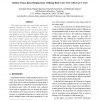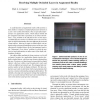ISMAR
2003
IEEE
14 years 8 months ago
2003
IEEE
Optical see-through head-mounted displays (HMDs) are less commonly used because they are difficult to accurately calibrate. In this article, we report a user study to compare the ...
ISMAR
2003
IEEE
14 years 8 months ago
2003
IEEE
Our purpose is to construct a new type interactive attraction which detects the user’s hand actions as triggers in a multi-participated mixed reality environment. “BLADESHIPS�...
ISMAR
2003
IEEE
14 years 8 months ago
2003
IEEE
In this paper, we propose a method for image overlay on the front glass of a vehicle to navigate a driver to a desired destination. By overlaying the navigation imformation on the...
ISMAR
2003
IEEE
14 years 8 months ago
2003
IEEE
In this paper, we describe the effects of shadow representation of virtual objects in Augmented Reality. Optical consistency is important in order to create realistic augmented re...
ISMAR
2003
IEEE
14 years 8 months ago
2003
IEEE
An ID recognition system is described that uses optical beacons and a high-speed image sensor. The ID sensor captures a scene like an ordinary camera and recognizes the ID of a be...
ISMAR
2003
IEEE
14 years 8 months ago
2003
IEEE
In the past, architectures of Augmented Reality systems have been widely different and taylored to specific tasks. In this paper, we use the example of the SHEEP game to show how...
ISMAR
2003
IEEE
14 years 8 months ago
2003
IEEE
This paper describes new vision-based registration methods utilizing not only cameras on a user’s head-mounted display but also a bird’s-eye view camera that observes the user...
ISMAR
2003
IEEE
14 years 8 months ago
2003
IEEE
This demonstration will highlight the Designer’s Augmented Reality Toolkit (DART), a system that allows users to easily create augmented reality (AR) experiences. Over the past ...
ISMAR
2003
IEEE
14 years 8 months ago
2003
IEEE
We present a fully automated approach to camera registration for Augmented Reality systems. It relies on purely passive vision techniques to solve the initialization and realtime ...
ISMAR
2003
IEEE
14 years 8 months ago
2003
IEEE
A useful function of augmented reality (AR) systems is their ability to visualize occluded infrastructure directly in a user’s view of the environment. This is especially import...



